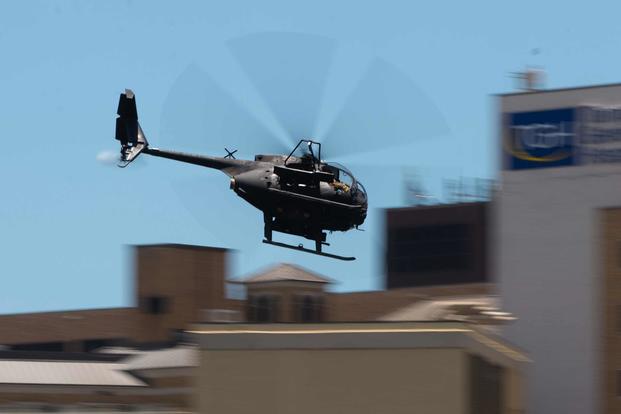The head of Army special-ops aviation hopes the service's Future Vertical Lift (FVL) effort will produce a specialized attack helicopter capable of inserting small teams on strategic missions.
Currently, the Army is developing Future Attack Reconnaissance Aircraft (FARA) and the Future Long Range Assault Aircraft (FLRAA), along with other airframes in the FVL effort, to give aviators greater range and speed over legacy aircraft such as the UH-60 Black Hawk beginning in 2030.
But Army Special Operations Aviation Command leaders are working with FVL program officials to see if the Future Attack Reconnaissance Aircraft could be modified to carry a small number of operators and serve as a possible replacement for the MH-6 Little Bird, Brig. Gen. Allan Pepin, commander of Army Special Operations Aviation Command, recently told an audience at an Association of the United States Army aviation symposium.
"So right now, if you look at ... the attack version [of FVL] we are pursuing, if we could actually mod that to have that assault capability, it would drive down the costs and we wouldn't have duplicate efforts in [Special Operations Command]," he said.
Related: Here's Why the Army's Not Afraid to Send its Future Helos Against Russian Air Defenses
"We know, for the most part, that SOCOM will be asked to do things for strategic reasons for our nation and for the Future Vertical Lift capability that SOCOM will most likely get in the future; we want to be nested up front, so we don't increase the modernization efforts after we get an Army common system."
SOCOM has dedicated future funding to FVL to build in options for specific modifications, so it doesn't have to "cut holes in aircraft" after they are delivered, said Brig. Gen. Walter Rugen, director of the Army's Future Vertical Lift Cross Functional Team.
"The work is going to be done on the front end so ... SOCOM doesn't have to modify aircraft," he said.
The Army expects to receive industry prototypes of the Future Attack Reconnaissance Aircraft in January from the five prototyping contracts the service awarded in April, Rugen said, adding that the service plans to down-select to two companies in March for competitive prototypes of FARA.
A competitive fly-off is planned for 2023, according to Rugen.
Pepin said that SOCOM may have to pursue a longer-term effort to replace the MH-6 if "it turns out that we cannot adjust or modify" the Future Attack Reconnaissance to carry operators into battle.
"If they need a critical capability to do a small assault force infil capability into a defined small space, whether that is doing shipboard operations or in an urban environment, then we will maintain that platform and that will be a long-term build that SOCOM will continue with," he said.
Other proposed special-ops modifications to the FVL aircraft are likely to be far less challenging, Pepin added.
"We know SOF will have to have an air-refueling requirement," he said.
Even though the aircraft will go faster and further, special operations aviators in some cases "will have to go through multiple countries to get to a target set," Pepin said.
"They are going to [configure] that aircraft so all we have to do is open a pre-designed hole and add a refueling probe," he explained.
Chris Van Buiten, vice president for Sikorsky innovations Lockheed Martin Corporation, said it will be relatively simple to add an in-flight refueling capability to either FVL aircraft design.
Sikorsky, part of Lockheed Martin Corp., and Boeing Co. built the SB>1 Defiant demonstrator for the FVL effort, based on Sikorsky's X2 coaxial design.
"It offers, I think, a tremendous opportunity for beyond special operations," Van Buiten said, adding that the capability will enable mission durations that aren't currently possible.
Maj. Gen. Dave Francis, commander of the service's Aviation Center of Excellence at Fort Rucker, Alabama, said the conventional Army has not determined whether the FVL aircraft will feature an in-flight refueling capability.
"The goal ... is to design the aircraft so you can plug and play those capabilities as required," he said. "What I think you are going to find in the future is that not everybody is going to get everything. We can't gold-plate everything.
"As a unit with a specific mission set has a requirement, we will identify those and make sure we have the capacity in the aircraft that is designed to plug that in as required," Francis said.
-- Matthew Cox can be reached at matthew.cox@military.com.
Read more: SEAL Team 7 Leaders Fired After Unit's War Zone Misbehavior












